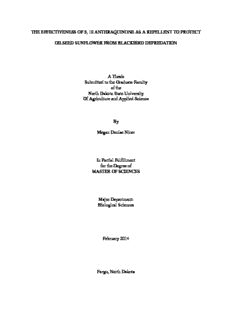
i THE EFFECTIVENESS OF 9, 10 ANTHRAQUINONE AS A REPELLENT TO PROTECT OILSEED ... PDF
Preview i THE EFFECTIVENESS OF 9, 10 ANTHRAQUINONE AS A REPELLENT TO PROTECT OILSEED ...
THE EFFECTIVENESS OF 9, 10 ANTHRAQUINONE AS A REPELLENT TO PROTECT OILSEED SUNFLOWER FROM BLACKBIRD DEPREDATION A Thesis Submitted to the Graduate Faculty of the North Dakota State University Of Agriculture and Applied Science By Megan Denise Niner In Partial Fulfillment i for the Degree of MASTER OF SCIENCES Major Department: Biological Sciences February 2014 Fargo, North Dakota North Dakota State University Graduate School Title THE EFFECTIVENESS OF 9, 10 ANTHRAQUINONE AS A REPELLENT TO PROTECT OILSEED SUNFLOWER FROM BLACKBIRD DEPREDATION By Megan Denise Niner The Supervisory Committee certifies that this disquisition complies with North Dakota State University’s regulations and meets the accepted standards for the degree of MASTER OF SCIENCE SUPERVISORY COMMITTEE: Mark Clark Chair George Linz Wendy Reed Jack Norland Approved: 03/13/14 Wendy Reed Date Department Chair ii ABSTRACT Across North America, blackbirds (Icteridae) cause heavy damage to sunflower crops annually, but effective methods limit blackbird damage to sunflower crops are lacking. I tested two repellents (active ingredient 9, 10 anthraquinone) under application conditions appropriate for large-scale, sunflower farming. In 2012, I conducted point counts and weekly crop damage surveys to assess blackbird use of plots of sunflowers, half of which were sprayed with Avipel. In 2013, six enclosures (three red-winged blackbirds, Agelaius phoeniceus, each) in a plot of sunflower treated with AV2022, and another six enclosures in an adjacent plot of sunflower left untreated. Results from 2012 indicate blackbird use of sunflower plots did not vary with Avipel treatment. Results from 2013 showed AV2022 treated sunflower plants had more seed loss than the untreated plot. I conclude that 9, 10 anthraquinone does not reduce blackbird damage to sunflower crops under typical methods for pesticides in large-scale, commercial agriculture. iii ACKNOWLEDGMENTS Special thanks to George Linz and Jeffery Homan for assisting during both study years. I also thank my field assistant Kristin Cattrano for her help in the field in collecting data for 2012. Lucas Wandrie and Nicole ‘Nik’ Snyder deserve recognition for putting personal projects and schoolwork on hold to assist me during the 2013 season. I also thank the Baasch’s and Goven’s for the use of their fields as well as the Farmers Union Oil Co. of Turtle Lake, ND and the Ever Green CO-OP of Tower City, ND, who took the time to spray our small plots. Funding was provided by the National Sunflower Association, the U.S. Department of Agriculture Wildlife Services’ National Wildlife Research Center, and North Dakota State University. Arkion Life Sciences LLC provided the Avipel® and AV2022 used in this study. These studies were conducted under WS-NWRC study protocols QA-2038 and 2121 (George M. Linz, Study Director) and NDSU IACUC protocol #A13006. Finally, I thank my major advisor, Mark Clark for his aid throughout the field seasons and in the statistical analysis of the data. iv TABLE OF CONTENTS ABSTRACT……………………….……………………...……………………………………...iii ACKNOWLEDGMENTS …………………………………………………………………….....iv LIST OF TABLES …………………………………….………………………………….……viii LIST OF FIGURES …………………………………………..……………………………..…...ix LIST OF ABBREVIATIONS...…………………………………………………...……………...x GENERAL INTRODUCTION……………………………………………………………………1 References…………………………………………………………………………3 CLARIFICATION OF DUAL-AUTHORED CHAPTERS………………………………………5 CHAPTER 1. THE IMPORTANCE OF SUNFLOWER IN AGRICULTURE ACROSS THE NORTHERN PLAINS OF NORTH AMERICA…………………………….…………...6 Literature Review………………………………………………………………….6 On the Origins of Sunflower in Agriculture………………………………6 Blackbird Life History…………………………………………………...10 Avian Management……………..……………………………..…………15 Chemical Avian Repellents……...………………………...……………..24 Avian Sensory Implications….…………………………………..………28 9, 10 Anthraquinone………………………………………………...……32 Conclusion……………………………………………………….………36 References………………………………………………………………………..36 CHAPTER 2. THE EFFECTIVENESS OF AVIAN REPELLENT 9,10 ANTHRAQUINONE WHEN APPLIED TO SUNFLOWERS AT THE R6 STAGE OF DEVELOPMENT….43 Abstract………………...……………………………………………………...…43 Introduction………………………………………………………………………43 Study Site……….……………………………………………………………..…46 v Methods…………….…………………………………………………………….49 Field Setup……………………………………………………………….49 Application of Anthraquinone….………………………………………..51 Point Counts...……………………………………………………………51 Vegetation Sampling……………………………………………………..52 Damage Assessment……………………………………………………..52 Residue Analysis…………………………………………………………52 Statistical Methods……………………………………………………….53 Results…………………………………………………………………………....54 Point Counts……………………………………………………………...54 Vegetation Sampling……………………………………………………..56 Damage Estimates………………………………………………………..60 Residue Analysis…………………………………………………………63 Discussion……………………………………………………………………..…65 Acknowledgements………………………………………………………………67 References………………………………………………………………………..68 CHAPTER 3. EFFECTS OF APPLYING 9,10 ANTHRAQUINONE TO PRE-SEED SET SUNFLOWERS ON HONEYBEES AND BLACKBIRDS…………………………………….70 Abstract………………....……………………………………………………..…70 Introduction………………………………………………………………...…….71 Study Site………………………………………………………………………...77 Methods…………………………………………………………………………..79 Blackbird Capture and Care……………………………………………...79 Field Setup……………………………………………………………….79 vi Anthraquinone Application…..…………………………………………..80 Honeybee Counts………………………………………………………...80 Field Enclosure Setup……………………………………………………81 Blackbird Observations….…….…………………………………………83 Sunflower Damage……………………………………………………….84 Residue Analysis…………………………………………………………84 Statistical Methods……………………………………………………….84 Results……………………………………………………………………………85 Honeybee Counts…………………...……………………………………85 Maintenance Diet Consumption Rates…………………………………...87 Sunflower Damage……………………………………………………….90 Residue Analysis…………………………………………………………94 Discussion………………………………………………………………………..94 Potential Risks to Pollinators….…………………………………………94 Implications for Use as an Avian Repellent...…………………………...95 Acknowledgements……………………………………………………………....98 References………………………………………………………………………..98 vii LIST OF TABLES Table Page 1. Weekly averages of plant characteristics per field treatment……………………………57 2. Test statistics from vegetation characteristic ANCOVAs…………………………….....58 viii LIST OF FIGURES Figure Page 1. Aerial view of field locations in McLean County, North Dakota.……………….……...48 2. Field design for divisions of treatment and control plots for each field in 2012………...50 3. Time and field effects on vegetation sampling…...……………………………………...59 4. Damage to sunflowers over time………………………………………………………...61 5. Box and whisker plot displaying sunflower damage by field ...…………………………62 6. AQ concentrations on bracts after each spray event and harvest………………………...64 7. Location of 2013 field in Barnes County, North Dakota………………………………...78 8. Field setup for 2013 cage enclosures…………………………………………………….82 9. Average number of bees per Julian day in treatment versus control plots………………86 10. Food consumed per bird*day per Julian day in treatment and control plots…………….88 11. Differences in average food consumption between treatment and control plots………...89 12. Box and whisker plot of sunflower damage inside control and treatment cages.………..92 13. Relationship between the covariate mean corn consumption and mean sunflower damage.…………………………………………………………………………………..93 ix LIST OF ABBREVIATIONS AQ…………………Anthraquinone COGR …………….Common grackle IACUC……………Institutional Animal Care and Use Committee NDSU……………..North Dakota State University PPR……………….Prairie Pothole Region RWBL ……………..Red-winged blackbird YHBL …………..…Yellow-headed blackbird UV………………....Ultra violet US EPA……………. United States Environmental Protection Agency USDA………………United States Department of Agriculture x
Description: